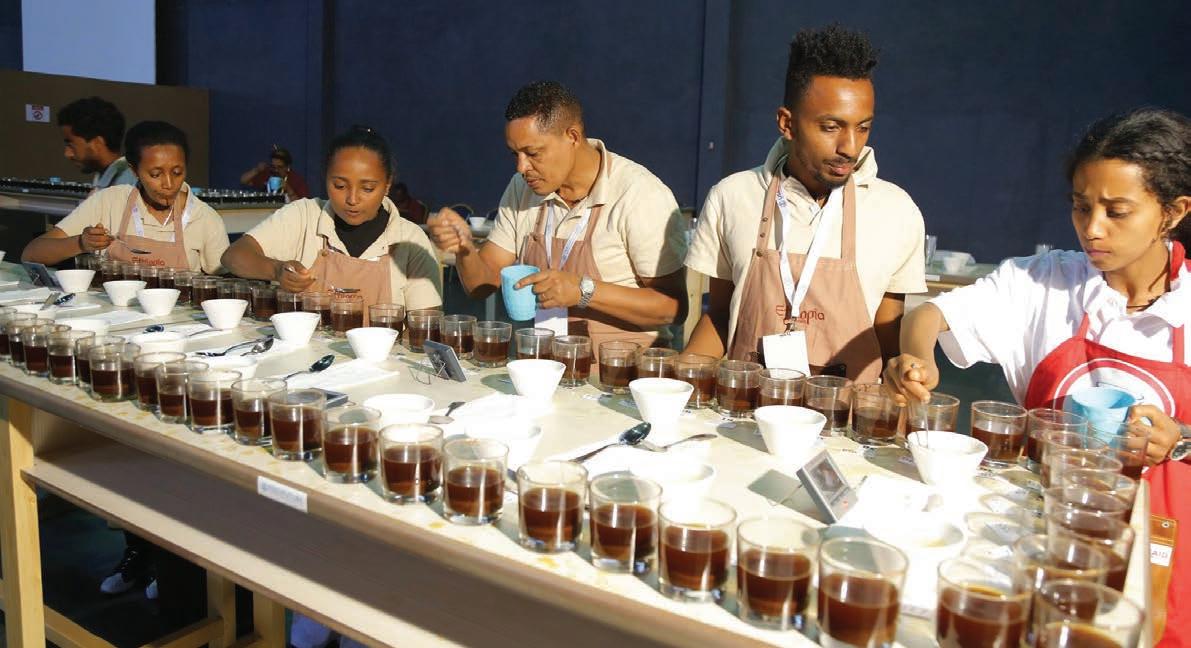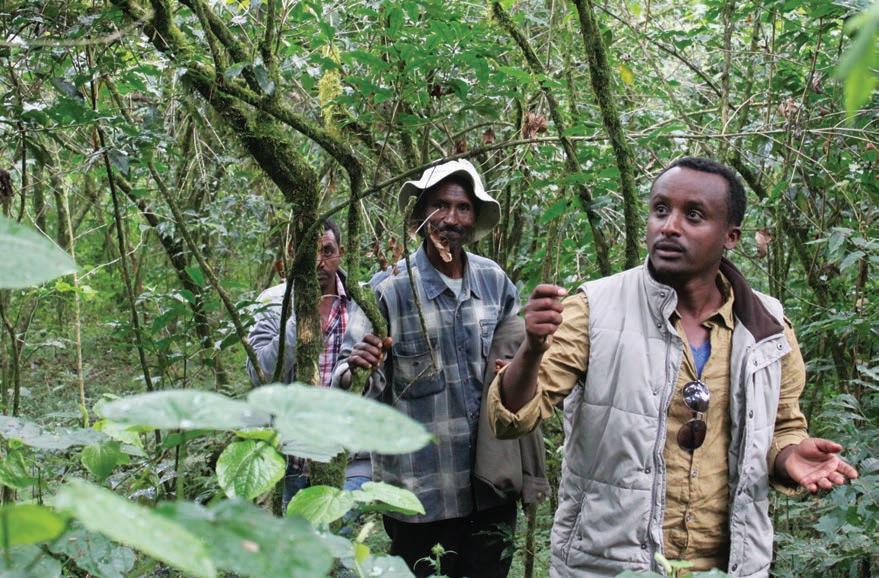
8 minute read
STARS ALIGN FOR ETHIOPIA
from GCR May 2020
by Prime Group
THE INAUGURAL CUP OF EXCELLENCE COMPETITION AND AN OPEN EXPORT MARKET ARE CREATING NEW OPPORTUNITIES FOR PRODUCERS.
This year, Ethiopia is hosting its first-ever Cup of Excellence (CoE) competition, the annual Alliance for Coffee Excellence (ACE) event that identifies and celebrates the highest-quality coffees around the world. The auction this summer is the culmination of years toiling on the farms, weeks of cupping and scoring, and navigating daily hurdles as the novel coronavirus spread globally and threatened to cancel the competition.
Given all the resources invested and record-levels of interest by farmers, ACE and its partners worked hard to ensure the competition stayed its course, albeit safely and with necessary modifications. The only major change, at the time of print, was the location of the inaugural event.
For the first time in the CoE’s 20-year history, the competition will take place outside of origin due to travel and socialdistancing restrictions of the coronavirus.
The top 150 pre-selection winners were stored in the Addis Ababa CoE Center before being sent to ACE’s homebase in Portland, United States, for national and international judging rounds from 30 March to 10 April. “Our members and board of directors have been demanding that we bring on Ethiopia at all costs,” says ACE Executive
Director Darrin Daniel. “Ethiopia is such a good fit for CoE for so many reasons: the coffee quality, diversity of regions, coffee culture, and history of the country. Everything we think about coffee comes back to Ethiopia, so some might say it’s a no-brainer.”
But he explains that picking the next new competition country is not nearly as simple as throwing a dart at the coffee belt map. First, there needs to be a certain level of quality for a country to qualify. Then there needs to be an organising partner in-country to help facilitate the various stages and a mandate from the host country to make it a national program. Lastly, proper infrastructure and funding is necessary to license the program and work with ACE, among other costs.
“They have to really want us to be there,” Daniel tells Global Coffee Report. “There has to be a profound desire to work within our standards because they’re very difficult standards and it’s not a cheap program. But if these countries really care about their producers, the impact for producers is pretty immeasurable. That’s what makes the stars align.”
For Ethiopia and the CoE, the stars truly did align. After liberalisation of the sector in 2017, ACE finally had the inroads into the country that it needed. It partnered with the Ethiopian Coffee & Tea Authority (CTA) and the US Agency for International Development (USAID) through its Feed the Future initiative.
According to Ian Chesterman, Chief of Party in the Feed the Future Ethiopian Value Chain Activity, the CTA organised a series of briefings across all of the key coffee production areas that were attended by more than 2800 farmers in late 2019, and then followed them up with a national radio and print media campaign.
Daniel says a typical first-year CoE competition sees about 400 to 500 entrants, but Ethiopia received a whopping 1462 submissions, 300-plus more than the previous record holder of Colombia.
“I think the interest is just testament to how excited they were that CoE was finally coming to Ethiopia,” admits Daniel. “Farmers [often] have a degree of skepticism when a foreigner comes in with a plan and promises to get high prices for them. That’s when you normally see people sitting back and waiting to see how the first year goes. That clearly didn’t happen here.”
ENDLESS VARIETIES Being coffee’s birthplace, Ethiopia has the most genetic diversity of coffee varieties in the world. In addition to wild cultivars, or “landraces” known among farmers for their specific traits, the Jimma Agriculture Research Center (JARC) has been breeding improved coffee varieties since the 1970s. Today, JARC has developed about 40 different coffee varieties. This includes varieties for disease resistance, drought tolerance, high yield, specialty-grade quality, and more, according to Getu Bekele, owner of Ethiopia-based G Broad Trading Private Limited Company and co-author of Counter Culture Coffee’s book A Reference Guide to Ethiopian Coffee Varieties .
Despite this vast collection, coffee buyers and roasters often lump Ethiopian coffee under the “Heirloom” label.
“There are more than one hundred different improved and local landrace coffee varieties that have been grown in different coffee producing areas in Ethiopia,” Bekele says. “Because information on these varieties was not reviewed and compiled in a very accessible way to the wider coffee community, very limited knowledge about Ethiopian coffee varieties has been shared and communicated in the global specialty coffee industry.”
This knowledge gap was the motivation for the varieties book Counter Culture published in 2018. “[Since then] we have seen a great deal of actions taken to decode the very generic descriptor
A whopping 1462 coffees were submitted in the inaugural Cup of Excellence Ethiopia competition.

‘Ethiopian Heirloom’ into the specific coffee variety names and their respective details. The book has been helping coffee buyers and roasters communicate more clearly about their coffee lots from the perspective of varieties,” Bekele tells GCR. “Similarly, coffee farmers are better informed of the types and characteristics of different Ethiopian coffee varieties. This, in turn, helps farmers make smart decisions during variety selection, which impacts coffee production, productivity, quality, and sustainability.”
Ethiopia’s main coffee-growing areas are largely located in the eastern, western, and southern regions of the landlocked country. According to Adugna Debela, Director General of CTA, the Oromia region is responsible for about 60 per cent of total production, and the Southern Nation Nationalities and Peoples (SNNP) region produces about 35 per cent. Both are in the southern half of the country, so the east and west regions produce the remaining 5 per cent.
Some districts within these regions are becoming more recognisable at the roaster and consumer levels for their specific characteristics. This is happening as Ethiopia’s varieties are further investigated and as consumers become more interested in coffee origins. Ethiopia has also branded a few of its growing districts, including Harrar, Limu, Sidama and Yirgacheffe.
“There is a significant level of difference among coffee regions for their quality profile, which is mainly due to differences in variety, environment, and agronomic practices. Due to these differences and their inevitable interactions, it is possible to produce a wide range of coffee quality profiles in Ethiopia,” Bekele explains. “The presence of diverse agroecology where coffee grows plays a great role in the production of different coffee types in Ethiopia. These include high altitudes, fertile soil, adequate amounts and distributions of rainfall, and adequate shade.”
INCREASING DEMAND TRENDS Smallholder farmers are responsible for 95 per cent of total production, a volume that has been increasing steadily since about 2012. The International Coffee Organization
estimates total production at nearly 7.8 million 60-kilogram bags for the 2018-19 harvest, making Ethiopia the fifth-largest producer globally.
The estimated 4.3 per cent increase from the previous year is “due to favourable weather conditions, including better rainfall, and less disease and pest pressure,” according to the USDA Foreign Agricultural Service’s GAIN Report. “Farmers are also benefiting from improved agriculture extension services from the government to support coffee production and marketing.”
Although farmers are up against some of the same challenges as the rest of the global coffee industry – increased pest and disease, climate change, aging trees and lack of access to necessary resources – production is climbing as industry reform and foreign investment have opened up markets and supported renovation programs.
The Ethiopia Commodity Exchange (ECX) was established in 2008 to reduce price volatility and incentivise increased production through a centralised trading system, according to the USDA, but it also effectively ceased any direct trade and created traceability issues – two things that have become increasingly important to coffee companies and consumers. In response, the government loosened ECX trading restrictions in 2017.
In addition to giving growers direct access to international markets, “Ethiopian coffee sector reform brought competitiveness to exporters, growers, suppliers, and service providers; improvements in coffee quality and traceability; export volume and value increment; and new investors into the coffee industry,” says Debela.
Like production, exports have been increasing steadily, especially due to Ethiopian coffee’s high value on international markets. In the 2018-19 harvest season, Ethiopia exported a record 3.8 million 60-kilogram bags of coffee, according to the ICO. But because Ethiopia consumes nearly half of its annual production – the top consumer in all of Africa – the country’s export ranking on a global scale isn’t as high as that of production. Because coffee has such a long history in the country, consuming it – whether casually over conversation or in a traditional coffee ceremony – is ingrained in the local culture.
This creates a tug-of-war between domestic and export demand. Considering coffee makes up about 34 per cent of total country export values, according to the USDA, the government mandates that high-quality coffees be reserved for export.

In the 2018-19 harvest season Ethiopia exported a record 3.8 million 60-kilogram bags of coffee.
Darrin Daniel
ACE Executive Director
In fact, “it is highly prohibited to sell high-quality coffees for local consumption”, explains Bekele. “It is only possible to supply lower-grade and rejected coffees to the local market. As a result, specialty coffee consumption has not [picked up] in Ethiopia the way it has around the globe.”
To manage the balance between export and domestic demand, Debela says the focus should be on continuing to increase production, particularly of specialty coffees.
This is where initiatives like CoE and Counter Culture’s book can boost awareness of Ethiopian coffee, which then helps drive interest at the farmer level to produce higherquality coffee.
“CoE provides momentum to encourage the emphasis on marketing specialty coffee rather than the traditional trading of commodity coffee,” says Chesterman. “The competition places farmers in direct contact with markets and buyers and promotes the true value of the best coffees to improve farm sustainability and encourage investment in best practices.” GCR










